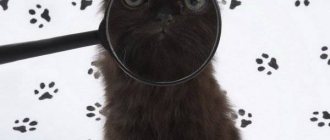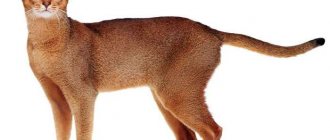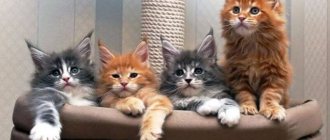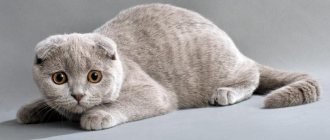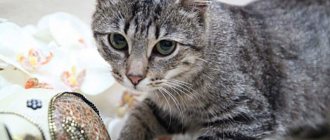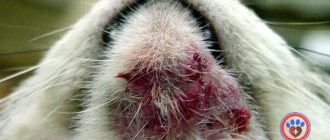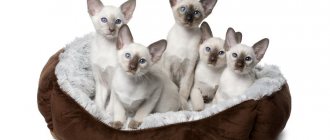Colors of Bengal cats
Bengal kittens cannot boast of a variety of colors, although as a result of the painstaking work of breeders who are constantly working to improve the breed standard, new, non-standard and rare ones appear. Wild fauna gave Bengals the patterned tabby color, which is the most common and recognizable, but the gorgeous marbled Bengal cat looks much more exotic.
According to the standard, the division is carried out according to the main background shade of the coat; two main types of colors are distinguished. All shades of golden, including yellow, orange, are called brown tabby; if the base of the coat has a gray-blue, silver color scheme, then the color is called silver tabby.
Depending on the shape of the pattern, these two types are divided into 3 subspecies:
- Spotted. Dark spots are located evenly throughout the body.
- Rosette. Light spots with a darker border around the edges.
- Marbled. Beautiful patterns of dark color, different in shape and size.
The face of Bengals has a classic color with a characteristic tabby pattern: dark, pronounced stripes on the sides, and the letter “M” on the forehead.
The modern Bengal cat has retained the appearance of wild cats. A common feature that is found in all types of color is a muzzle of a classic color with a characteristic tabby pattern - clear dark stripes on the sides of the muzzle, the letter “M” on the forehead. On the neck there is a “necklace”, on the shoulders there are small spots, stripes or even a “decoration” in the form of a butterfly. The paws are spotted or striped.
The tail can have both rings and rosettes, but the tip is always black. The fur on the tummy is lighter than the main background; the presence of spots is desirable. Breeders strive to achieve maximum resemblance to leopards, but which gene is responsible for the color has not yet been established.
Let's look at the most popular colors of Bengals.
Varieties of colors
The color or “background” of Bengals is as follows:
- The fur color is brown or golden.
- Silver coat color.
- Snowy coat color.
- Blue fur color.
- Ash, or otherwise charcoal, fur color.
Rosette on gold
According to international classification:
- BEN n 24 – spot on gold.
- BEN n 22 – marble on gold.
Eyes. Breed standard. Large, oval. Widely spaced. Any color except turquoise and blue for tabbies, for linx only bright blue.
The most popular skin color is a spot or rosette on gold. The most characteristic features of Bengals are combined in this color. These cats have a large, elongated head. The whisker pads are clearly defined. The ears are rounded and small, the front legs are slightly shorter than the hind legs. Muzzles with a typical brindle color, with the letter “M” on the forehead. A necklace of lines around the neck. Specks in the shoulder area, beautiful stripes or spots in the shape of a butterfly, striped or spotted paws and tail.
Bengals sometimes need to be walked on a leash due to the fact that they are active and energetic animals. This is also good for the skin.
Snow color
Very rare color. This animal looks like a small snow leopard. The color of the spots varies - from black to reddish. The coat is very light in color. Separately, this color is divided as follows:
Sepia
International classification – BEN n 31. Dark snowy color. The coat color ranges from golden to light orange. The spots stand out slightly. The end of the tail is chocolate-colored, with similar pads on the paws. The eyes are golden in color.
Mink
BEN n 32. Fur coat from cream to golden color. The coat pattern ranges from orange to light brown. Spots from the main background stand out faintly. Aquamarine eyes. Small mink and sepia kittens are white at birth; only specialists can distinguish them. Sometimes you even have to study their genes to determine their color.
Links
According to the classification BEN n 33. These kittens are also born completely white. They may only develop color when they are one year old. The main distinguishing feature of this animal is blue eyes and dark spots on the face, ears, paws and tail. The color of the skin is cream.
Over time, the kitten's shade becomes much denser, but the contrast will remain at the same level.
Silver
BEN ns 24. The main predominant color of this variety of Bengals is light, and the tips of the hairs are ashen or black. This background has a spotted or marbled pattern. Spots and stripes contrast with the color. These animals may have darker fur along the back. There are black spots on the lips, eyes and nose, but the tip of the nose is certainly pink.
Marble
Classification BEN ns 22. A specific feature of marbled cats is a complex horizontal pattern with irregular patterns. It looks impressive and is not found in nature. The advantages of the color include the presence of three shades - an additional pattern and edging of the pattern.
Ash or charcoal
According to BEN classification n 24 charcoar. The pattern of this variety is jet black, but the color of the base background is cool light. The skin in the eye area is light, as if an animal is wearing glasses. Although this is a popular variety, it is unofficial and is not evaluated at exhibitions.
Blue
BEN a 24. Very rare coloring of a non-standard type. The color of the skin is grey-blue, with a slight peach tint in the chest area. The pattern is patterned, gray in color. Felinologists have recognized this color as official.
Rare colors of Bengals
BEN n 24 melanistic. Panther in miniature. Unrecognized, extremely rare and expensive color. The “black panther” is especially beautiful. At first glance, these cats are a single color, but from a certain angle of view, spots and stripes are visible. Melanistics come in every color.
Stains and rosettes on gold
The background shade is predominantly warm - orange, golden. Ginger cats are the most popular.
INTERESTING TO KNOW: The domestic Bengal cat is a loyal animal
In the areas of the chin, on the whisker pads, abdomen, chest and inner side of the limbs, the tone is noticeably lighter than the main one.
The pattern in the form of spots or rosettes is dark, contrasting with the main color (chocolate, black, dark brown). The pads of the paws, the rim around the eyes, and the tip of the tail are black. The nose is brick red. Eye color varies from yellow to green.
Longhaired Bengal cat (Cashmere/Cashmere Bengal)
Obtaining a new breed of cats requires a proper numerical population so that the offspring have a stable new trait and are healthy. Therefore, at the formation stage, other breeds are often used. The selection of Bengal cats followed a similar path, since constantly crossing with wild cats makes it difficult to obtain a balanced domestic temperament. The Egyptian Mau, Siamese, Burmese and other breeds contributed. The long hair gene, being recessive, is periodically found in Bengal cats. These animals are not involved in breeding, since long-haired Bengals are not recognized by most feline systems. The Cashmere Bengal (Kashmir) has a semi-long coat with a similar pattern to the short-haired representatives. The coat has a fine, silky texture, close-fitting, with harmonious transitions from shorter to longer coats. A “collar” on the neck is possible. Glitter may also be present. The drawing is clear, contrasting, horizontal.
Marble cat
Marble color is characterized by complex horizontal stains of irregular shape. The presence of three shades in color looks most impressive and is considered an advantage of the breed: the main background, a dark pattern, and a dark edging of the pattern. Spots on the tummy are required.
Marbled Bengal cats with spots - circular stains of a vague shape, the so-called bull's eyes, can be disqualified from the exhibition.
Bengal character
Despite their exotic appearance, Bengal cats have a friendly, domestic character. They enjoy interacting with people and therefore can become beloved companions. Cats have an equally positive attitude towards other pets, with the exception of birds and rodents.
Bengals are especially comfortable communicating with children, for whom they are always ready to keep a cheerful company. The greatest interest in cats is caused by games that imitate “hunting” - catching flywheels, racing for balls, chasing and chasing, etc. It is important that cats remain fidgety throughout their lives, which distinguishes them favorably from representatives of other breeds.
Silver color
The background color of the coat is white-silver, light. An important feature of the color is the coloring of each hair in stripes of ash-gray or black. The pattern on the coat can be spots, rosettes, marbled silver and contrast with the base color of the coat.
The eyes, nose and lips have a black edging, the abdominal area, the inside of the limbs, most of the body is several tones lighter than the main background. On the back, as a rule, there is a darkening, this is acceptable according to the breed standard. The nose is red, pink or brick. Eye color ranges from rich green to golden.
Snow color
Experts believe that the snow color is the most original and spectacular. It is the lightest of all existing colors, but the color palette is more extensive.
The Snow Bengal, in turn, depending on the genotype, may include the following types of color:
- Sepia. The main background is golden, close to light orange. The color of the body and spots does not vary too much. The tip of the tail and paw pads are dark brown. Eyes - yellow or golden. It is considered the darkest snow color.
- Minx. The base background is cream and golden. The pattern on the body is dark orange, light brown, contrasting with the base color. The eyes are bright blue. The tip of the tail is dark brown.
- Links. Base color - ivory, cream. The paws, muzzle, tail, ears are darker than the main background. Eye color - blue. The pattern is predominantly marbled, but rosettes and spots may be present.
It is worth noting that kittens of Minx, Lynx, and Sepia colors are born white or very light; as they grow older (not earlier than a year), the pattern becomes clearer.
Minx and sepia are visually difficult to distinguish, sometimes a genetic examination is required to accurately determine the color.
BENSHARM
It’s just that in color genetics it is generally accepted that all cats are either black or red. All other variations are based on them. And we see the background color of a Bengal cat as golden, although it is not considered golden, and accordingly the criteria for assessing golden color are not applicable to it. And only among the people this coloring is called “rosette on gold”.
It would seem that cats of this color should be similar. But in fact, you will never find two identical Bengals, even if both have this same black spotted tabby (n24) in their pedigree! Starting from the background, which according to the standard can vary from light to dark and from golden to red-red, to spots - they can be medium-sized single spots, large single-color spots or “rosettes” - two- or three-color spots. Rosettes, in turn, can also be different - “darts”, when the spot has the shape of an arrowhead with color transitions from light to dark, “open rosette” - a kind of semicircle or semi-oval with an open contour, “donut” - a classic “steering wheel” with a clear outlined contour and highlighted middle. Rosettes and spots can be fused, forming bizarre patterns, but the main requirement for them is the horizontal orientation of the pattern, the absence of straight vertical lines (the so-called “edges”). The color of the markings can also range from brown to jet black, the preference is not specified by the standard, but a clear contrast between the background and the markings is desirable.
Here it is worth paying attention once again to the concept of “ribs” in the Bengal color. Beginning breeders, when choosing their first cat, very often pay attention to the absence of ribs, while not always understanding the difference between a “rib” and “fused rosettes.” In simple terms, a “rib” is a clear, often thin, vertical line running from the back to the belly. Such lines in the color of breeding animals are extremely undesirable. Fused sockets are another matter. They are, so to speak, wavy lines, diagonal or sometimes vertical. Although such marks are considered a fault, they are not assessed very strictly. They are considered in the general impression of color. Most experienced breeders, when choosing a new breeding animal, will give preference to a bright, contrasting animal with fused rosettes over the boring, dull and non-contrasting color of an animal that does not have such a defect.
Marble drawing
The next variety of “golden” color is black marbled (patched) tabby or in WCF code - n22, where 22 is a marbled pattern. The merle in the Bengal color appeared thanks to other breeds used in breeding during the formation of the breed. However, the genes of Asian leopard cats gave the Bengal marble undeniable advantages over other breeds. The fact is that in all cat breeds the marbled pattern again has a vertical orientation, while the marbled color of a Bengal cat tends to be horizontal. And if we add relief to this, then we can say with confidence that the marbled color of the Bengal cat is unique. However, this color also has its own nuances. The simplest division (which is by no means complete) is the division into “cloak”, “patterned” and “ribbon” marble. The last one looks the most impressive, although the patterned one is also very beautiful. The raincoat does not look so elegant, because... the main color seems simply black, but it is no less valuable due to its beautiful glitter tint and because of its value for working on rosette color. The fact is that the color of the Asian leopard cat, the founder of the Bengal breed, is not distinguished by large rosette spots, and the modern idea of Bengal cats elevates the color specifically to leopard. And it is to transform a small spot into a beautiful large rosette that cats with a coated marble color are used.
The merle color is transmitted by recessive genes. Therefore, a cat that has the marble gene and the spotted gene will always have a spotted color. When crossing two animals with such genetics, the birth of both spotted and marbled kittens is possible. However, if at least one of the parents does not carry the merle gene, then the birth of merle kittens is excluded. At the same time, the birth of spotted offspring from two merle parents is impossible. Nowadays it is very difficult to find a cat or cat that does not have merle in its genetics. But such cats do exist. Moreover, the absence of marble in the observable pedigree does not indicate the absence of this gene in the animal in question. For now, such carriage can only be detected experimentally.
Unfortunately, marble color is undeservedly less in demand than the classic “rosette”. Most likely, this is due to the desire to see exactly a copy of a wild animal. But, fortunately, lately this color has been gaining more and more admirers. There are nurseries (mostly foreign for now) that work with this particular color of Bengal cat and produce truly magnificent animals.
Silver color
The next color variety of Bengal cats differs from the previous ones in the background color. This is a silver color, also known as silver spotted (ns 24) or silver marbled (ns 22). Accordingly, in this color the markings are the same as in the previous one, with all the ensuing requirements. But the background has a silver tint. Here the variations in shades are not so pronounced and are reduced to lighter/darker. Probably the only requirement is the absence of rufisms (the so-called areas with a red, rusty tint on a silver background).
Snow color
Well, the last group of recognized colors is snow. In terms of design, this color also does not differ from the others. But according to the background color it is divided into 2 groups - seal lynx and mink. The first one refers to point colors, i.e. has pronounced darkened areas on the face, tail, and paws. Some semblance of a Siamese color. Representatives of this color of the Bengal breed with a pronounced pattern are truly beautiful and unique. And this is the only color of the Bengal cat in which the animals have blue (or rather blue) eyes. Kittens of this color are born completely white and only with age they gain color saturation (pointed areas appear first, and then the pattern). The difficulty of working with this color lies in the fact that the color reaches full bloom by about two years, and breeders are forced to make decisions about breeding this animal much earlier, based only on experience and forecasts.
Mink is also a beautiful color. Cats of this color have a more uniform tone, baked milk colors and brown markings. Aqua colored eyes. Kittens of this variety of snow color are born with a visible pattern, but also blossom over time.
"Charcoal", "blue" and other colors
Finally, I would like to add a few words about unrecognized colors. Now work is underway on such colors as “charcoal”, “blue” and others. These are varieties of golden (black) color, and in pedigrees they are now recorded as such. Due to the very vague description of the standard regarding the background color of the color, animals of this color participate in exhibitions and receive divorce marks. However, in reality, these are still unrecognized colors, work on which is still underway. The most notable is the “charcoal” color, which in itself is quite unique - a very dark background (as if stained with coal) and the same dark markings (spot or marble). Because of this, the color looks completely non-contrasting, but very attractive. Using this color in breeding helps to achieve good contrast, and the so-called “tanned” cats look simply stunning. The use of charcoal also produces another variation of an unrecognized color - melanistic. Cats of this color are completely black. However, very often in the light, at a certain angle, even darker spots (rosettes) or a marble pattern can be distinguished. Currently, animals of this color are used to breed a new breed - the pantherette.
Ash or charcoal color
This type of color belongs to the brown tabby, but is characterized by a cooler, lighter tone of the base background. The large pattern on the body and muzzle is jet black.
INTERESTING TO KNOW: The St. Petersburg Sphynx is a devoted cat
The cat's eyes are outlined with a light stripe, giving the impression that the animal is wearing glasses. The black color today does not have official recognition and is not included in the standard, although it is very popular among Bengals.
Color development in Bengal cats
Bengal cats are considered the most expensive in the world. This is explained by many factors. Great difficulties in breeding, intelligence and intelligence, habits. REFERENCE: Bengals love dogs and playing with them. Like dogs, they are “prone” to protecting their territory. This breed “loves” to sit at high altitudes – it climbs to the highest points in the apartment. Bengal cats often refuse to mate with domestic cats, and many of the cats are infertile. The price of this breed reaches up to 200,000 US dollars! All colors of Bengal cats are very beautiful, but the “fullness” and depth of color does not come immediately, but after 7 – 8 months, like the “ugly duckling”. Therefore, their customers are initially confused “what to pay for?” This is explained simply - by the word “phasing”. The word means a method of natural camouflage for kittens. A Bengal cat is worth purchasing. To do this, it is not enough to love animals, but you also need a supply of free time. Thanks to her intelligence and other “dog” qualities, she can become a real companion and partner to her owner.

